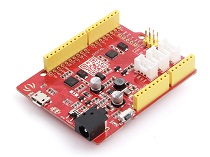Grove - Mini Track Ball

Grove - Mini Track ball will give an easy access to prototyping a practical motion-tracking function module for your applications. It has implanted 360° detection and click detection with high accuracy and quick response. With chips STM32F103C8T6 and AN48841B inside, you can turn plenty of your ideas into tangible things. It is also standardized with Grove interface which will save you a lot of work in the prototyping process.
Features
- 360° and quick detection.
- Translucent click Button.
- Standardized with Grove interface.
- Powerful MCU for you to enrich your applications.
More details about Grove modules please refer to [Grove System](https://wiki.seeedstudio.com/Grove_System/)
Application ideas
- Tracking module for a gamepad.
- Tracking module for a haptic controller.
- Tracking module for toys.
Specifications
| Parameter | Value |
|---|---|
| Operating voltage | 3.3V~5.5V (typical at 5V) |
| Operating current | 28 mA (maximum operating current: 40 mA) |
| Operating temperature range | -25 ~ 75 ℃ |
| MCU frequency | 64 MHz |
| Operating frequency | 105±5kHz |
| Hall effect filed strength range | (0.5) ~ (8) mT |
| I2C Address | 0x4A |
Hardware Overview

Grove interface
Connect main control board such as Seeeduino board with Grove - Mini Track Ball.MCU (STM32F103C8T6)
Microcontroller.Track ball
Interface to control motions.
Getting started
Play with Arduino
Hardware
- Step 1. Prepare the below stuffs:
| Seeeduino V4.2 | Grove-Mini_Track_Ball |
|---|---|
|
|
| Get One Now | Get One Now |
- Step 2. Connect Grove-Mini_Track_Ball to I2C port of Seeeduino.
- Step 3. Connect Seeeduino to PC via a USB cable.

Software
Step 1. Download the demo from Github.
Step 2. Open the file Grove - Mini Track ball test.ino
#include <Wire.h>
/*---------------------------------------------------------------------------------------//
* define the default data
*/
#define ReadMode 0
#define WriteMode 1
#define DeAddr 0X4A
#define ConfigValid 0x3a6fb67c
/*---------------------------------------------------------------------------------------//
* define the enum type for Register
*/
enum MOTION_REG_ADDR
{
MOTION_REG_UP = 0X00,
MOTION_REG_DOWN,
MOTION_REG_LEFT,
MOTION_REG_RIGHT,
MOTION_REG_CONFIRM,
MOTION_REG_NUM
};
enum CONFIG_REG_ADDR
{
CONFIG_REG_VALID = MOTION_REG_NUM,
CONFIG_REG_I2C_ADDR = CONFIG_REG_VALID + 4,
CONFIG_REG_I2C_SPEED,
CONFIG_REG_LED_MODE = CONFIG_REG_I2C_SPEED + 2,
CONFIG_REG_LED_FLASH_TIME,
CONFIG_REG_DATA_CLEAR_TIME = CONFIG_REG_LED_FLASH_TIME + 2, //CONFIG_REG_LED_FLASH_TIME has 2bytes
CONFIG_REG_DATA_READ_TIME = CONFIG_REG_DATA_CLEAR_TIME + 2,
CONFIG_REG_NUM = CONFIG_REG_DATA_READ_TIME + 2
};
/*---------------------------------------------------------------------------------------//
* define the LED word mode
*/
enum LED_MODE
{
LED_FLASH_1 = 0X00,
LED_FLASH_2,
LED_FLASH_TOGGLE,
LED_FLASH_ALL,
LED_ALWAYS_ON_1,
LED_ALWAYS_ON_2,
LED_ALWAYS_ON_ALL,
LED_ALWAYS_OFF,
LED_BREATHING_1,
LED_BREATHING_2,
LED_BREATHING_ALL,
LED_MOVE_FLASH,
LED_MODE_NUM
};
/*---------------------------------------------------------------------------------------//
* Write one byte into register
*/
void WriteByte(uint8_t Reg, uint8_t Value)
{
Wire.beginTransmission(DeAddr);
Wire.write(WriteMode);
Wire.write(Reg);
Wire.write(Value);
Wire.endTransmission();
}
/*---------------------------------------------------------------------------------------//
* Write N byte into register
*/
void WriteNByte(uint8_t Reg , uint8_t * Value , uint8_t len)
{
Wire.beginTransmission(DeAddr);
Wire.write(WriteMode);
Wire.write(Reg);
for(int i = 0;i<len;i++)
{
Wire.write(Value[i]);
}
Wire.endTransmission();
}
/*---------------------------------------------------------------------------------------//
* Write one word(4 bytes,32 bits) into register ,the register address must be continuous
*/
void WriteOneWord(uint8_t Reg, uint32_t Value)
{
uint8_t tmp[4]={0};
tmp[0] = (Value>>0)&0XFF;
tmp[1] = (Value>>8)&0XFF;
tmp[2] = (Value>>16)&0XFF;
tmp[3] = (Value>>24)&0XFF;
WriteNByte(Reg,tmp,4);
}
/*---------------------------------------------------------------------------------------//
* Write half word(2 bytes,16 bits) into register ,the register address must be continuous
*/
void WriteHalfWord(uint8_t Reg, uint16_t Value)
{
uint8_t tmp[2]={0};
tmp[0] = (Value>>0)&0XFF;
tmp[1] = (Value>>8)&0XFF;
WriteNByte(Reg,tmp,2);
}
/*---------------------------------------------------------------------------------------//
* Read one byte from register
*/
uint8_t ReadByte(uint8_t Reg)
{
Wire.beginTransmission(DeAddr);
Wire.write(ReadMode);
Wire.write(Reg);
Wire.write(1);
Wire.endTransmission();
Wire.requestFrom(DeAddr, 1);
return Wire.read();
}
/*---------------------------------------------------------------------------------------//
* Read half word from register
*/
uint16_t ReadHalfWord(uint8_t Reg)
{
uint16_t tmp;
tmp = ReadByte(Reg);
tmp |= ((uint16_t)ReadByte(Reg+1))<<8;
return tmp;
}
/*---------------------------------------------------------------------------------------//
* Read one word from register
*/
uint32_t ReadOneWord(uint8_t Reg)
{
uint32_t tmp;
tmp = ReadByte(Reg);
tmp |= ((uint32_t)ReadByte(Reg+1))<<8;
tmp |= ((uint32_t)ReadByte(Reg+2))<<16;
tmp |= ((uint32_t)ReadByte(Reg+3))<<24;
return tmp;
}
/*---------------------------------------------------------------------------------------//
* Set LED mode ,reference to the enum type LED_MODE
*/
void SetLedMode(uint8_t LED_MODE)
{
WriteByte(CONFIG_REG_LED_MODE,LED_MODE);
}
/*---------------------------------------------------------------------------------------//
* test api ,Set LED mode circularly ,reference to the enum type LED_MODE
*/
void test_SetLedMode(void)
{
unsigned char tmp[8]={0};
for(int i=0;i<LED_MODE_NUM;i++)
{
//WriteByte(CONFIG_REG_LED_MODE,(enum LED_MODE)i);
tmp[0] = i;
WriteNByte(CONFIG_REG_LED_MODE ,tmp , 1);
delay(5000);
}
}
/*---------------------------------------------------------------------------------------//
* test api,print the track ball data
*/
void test_PrintTrackData(void)
{
for(int i=0;i<500;i++)
{
Serial.print(ReadByte(MOTION_REG_UP));
Serial.print("-");
Serial.print(ReadByte(MOTION_REG_DOWN));
Serial.print("-");
Serial.print(ReadByte(MOTION_REG_LEFT));
Serial.print("-");
Serial.print(ReadByte(MOTION_REG_RIGHT));
Serial.print("-");
Serial.println(ReadByte(MOTION_REG_CONFIRM));
delay(100);
}
}
/*---------------------------------------------------------------------------------------//
* test api,Write register
*/
void test_WriteReg(void)
{
unsigned char tmp[8]={0};
tmp[0] = 0X4A;
WriteByte(CONFIG_REG_I2C_ADDR ,tmp[0]);
delay(100);
tmp[0] = 0X64;
tmp[1] = 0X00;
WriteByte(CONFIG_REG_I2C_SPEED ,tmp[0]);
WriteByte(CONFIG_REG_I2C_SPEED+1 ,tmp[1]);
delay(100);
tmp[0] = 10;
WriteByte(CONFIG_REG_LED_MODE ,tmp[0]);
delay(100);
tmp[0] = 0xc8;
tmp[1] = 0x00;
WriteByte(CONFIG_REG_LED_FLASH_TIME ,tmp[0]);
WriteByte(CONFIG_REG_LED_FLASH_TIME+1 ,tmp[1]);
delay(100);
tmp[0] = 0XEA;
tmp[1] = 0X14;
WriteByte(CONFIG_REG_DATA_CLEAR_TIME ,tmp[0]);
WriteByte(CONFIG_REG_DATA_CLEAR_TIME+1 ,tmp[1]);
delay(100);
tmp[0] = 0X22;
tmp[1] = 0X05;
WriteByte(CONFIG_REG_DATA_READ_TIME ,tmp[0]);
WriteByte(CONFIG_REG_DATA_READ_TIME+1 ,tmp[1]);
delay(1000);
Serial.println("Setted Value are over here");
Serial.print("valid:0x");Serial.print(ReadByte(CONFIG_REG_VALID+3),HEX);Serial.print(ReadByte(CONFIG_REG_VALID+2),HEX);Serial.print(ReadByte(CONFIG_REG_VALID+1),HEX);Serial.println(ReadByte(CONFIG_REG_VALID+0),HEX);
Serial.print("I2C_ADDR:0x");Serial.println(ReadByte(CONFIG_REG_I2C_ADDR+0),HEX);
Serial.print("I2C_SPEED:0x");Serial.print(ReadByte(CONFIG_REG_I2C_SPEED+1),HEX);Serial.println(ReadByte(CONFIG_REG_I2C_SPEED+0),HEX);
Serial.print("LED_MODE:0x");Serial.println(ReadByte(CONFIG_REG_LED_MODE+0),HEX);
Serial.print("LED_FLASH_TIME:0x");Serial.print(ReadByte(CONFIG_REG_LED_FLASH_TIME+1),HEX);Serial.println(ReadByte(CONFIG_REG_LED_FLASH_TIME+0),HEX);
Serial.print("DATA_CLEAR_TIME:0x");Serial.print(ReadByte(CONFIG_REG_DATA_CLEAR_TIME+1),HEX);Serial.println(ReadByte(CONFIG_REG_DATA_CLEAR_TIME+0),HEX);
Serial.print("DATA_READ_TIME:0x");Serial.print(ReadByte(CONFIG_REG_DATA_READ_TIME+1),HEX);Serial.println(ReadByte(CONFIG_REG_DATA_READ_TIME+0),HEX);
Serial.println();Serial.println();Serial.println();
delay(3000);
}
/*---------------------------------------------------------------------------------------//
* test api,Set all config to default value
*/
void test_SetDefault(void)
{
unsigned char Zero[]={0,0,0,0};
Serial.println("Setting Default Value");
WriteNByte(CONFIG_REG_VALID , Zero , 4);
delay(100);
Serial.println("Default Value are over here");
Serial.print("valid:0x");Serial.print(ReadByte(CONFIG_REG_VALID+3),HEX);Serial.print(ReadByte(CONFIG_REG_VALID+2),HEX);Serial.print(ReadByte(CONFIG_REG_VALID+1),HEX);Serial.println(ReadByte(CONFIG_REG_VALID+0),HEX);
Serial.print("I2C_ADDR:0x");Serial.println(ReadByte(CONFIG_REG_I2C_ADDR+0),HEX);
Serial.print("I2C_SPEED:0x");Serial.print(ReadByte(CONFIG_REG_I2C_SPEED+1),HEX);Serial.println(ReadByte(CONFIG_REG_I2C_SPEED+0),HEX);
Serial.print("LED_MODE:0x");Serial.println(ReadByte(CONFIG_REG_LED_MODE+0),HEX);
Serial.print("LED_FLASH_TIME:0x");Serial.print(ReadByte(CONFIG_REG_LED_FLASH_TIME+1),HEX);Serial.println(ReadByte(CONFIG_REG_LED_FLASH_TIME+0),HEX);
Serial.print("DATA_CLEAR_TIME:0x");Serial.print(ReadByte(CONFIG_REG_DATA_CLEAR_TIME+1),HEX);Serial.println(ReadByte(CONFIG_REG_DATA_CLEAR_TIME+0),HEX);
Serial.print("DATA_READ_TIME:0x");Serial.print(ReadByte(CONFIG_REG_DATA_READ_TIME+1),HEX);Serial.println(ReadByte(CONFIG_REG_DATA_READ_TIME+0),HEX);
Serial.println();Serial.println();Serial.println();
delay(3000);
}
void setup() {
Wire.begin();
Serial.begin(115200);
}
void loop() {
test_SetLedMode();
test_PrintTrackData();
test_WriteReg();
test_SetDefault();
delay(3000);
}
Step 3. Upload your code into Seeeduino board. If uploading process is done, to open Serial Monitor window, Click Serial Monitor under menu Tool.
Step 4. LED indicator under tracking ball will light on in different mode which will last around 50 seconds
Step 5. After that you can rotate or "click" the track ball to get information of its trace.
Resources
- [Eagle] Grove-Mini Track ball v1.0 schematic
- [PDF] Grove-Mini Track ball v1.0 schematic
- [Datasheet] STM32F103C8T6 Datasheet
- [Datasheet] AN48841B Datasheet
- [Library] Library file in Github
Tech Support & Product Discussion
Thank you for choosing our products! We are here to provide you with different support to ensure that your experience with our products is as smooth as possible. We offer several communication channels to cater to different preferences and needs.


